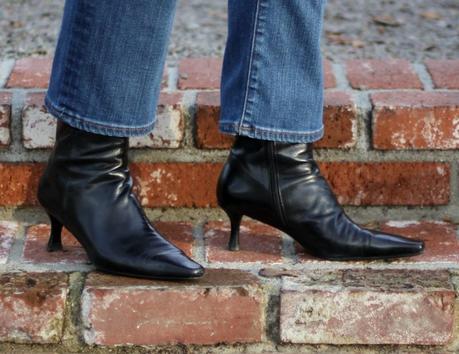
I’ve had a few questions in recent months about wardrobe investment pieces. I think it’s a given that no matter our budgets, we all want to shop smarter and avoid costly mistakes. But what do we mean when we talk about “investment pieces?” It can be rather subjective, but here are my thoughts….
Crunching The Numbers
As clothing and accessories rarely appreciate in monetary value, a wardrobe investment can’t (and shouldn’t) be measured that way. (Of course, some high-end designer pieces have historically gone up in price, but that’s a discussion for another day.) My best investments have been those that add value to my wardrobe. So how to quantify “value?”
After noodling this over for a few weeks, I’ve realized I have two different criteria for determining value. The first is what I’ve often referred to as amortizing, or cost-per-wear. In general, I’ve found it’s worth spending a little more for those pieces that a) are of higher quality b) fit better and c) are more versatile because I’ll wear them more often, for longer, and the cost-per-wear of the item amortized over its “lifespan” will be much lower. My Eileen Fisher silk tanks and tees weren’t inexpensive, but I wear one of them almost daily, they wear like iron and last for years. At this point, my cost-per-wear on these is down to pennies.
It can be hard to know the first time you make a purchase how well that piece is going to perform in your wardrobe. That’s where having a signature style, or at least leaning toward one or two silhouettes can help. My closet orphans (pieces that I’ve bought and worn once or twice, if at all) were often experiments, or steps broadly outside of my usual style or silhouette. Once you know the types of pieces and styles that work best for you, it becomes less risky to spend a little more for better quality.
Feeling The LOVE
But we can’t live by numbers alone. There’s an emotional component to style that we shouldn’t ignore. Sometimes the value something adds to your wardrobe isn’t measured by number of wears, but how you feel wearing it, and how sometimes it’s just the thing that makes an outfit come together. I consider the pieces I’ve LOVED LOVED LOVED the minute I tried them on to be some of my best wardrobe investments; they’re what add the “wow” factor to my wardrobe. I find ways to wear things I love more often, and I keep them longer. They make both financial and emotional sense. (And the author of this recent NY Times article comes to the same conclusion about buying what you love.)
It can be tempting when you find something you LOVE that’s out of your budget to want to “buy around” it, and find something else that scratches the same itch for less. Sometimes you can. But I’d caution…if the substitute doesn’t give you that same feeling, skip it and save up for the next Wonderful Thing that does. Like like passing up a scoop of gelato only to binge on a fat-free-sugar-free substitute later, you may often end up spending more over time without the satisfaction. Watch for sales, and check ebay, etsy and consignment sites too.
I’ve often heard advice not to spend on really trendy things because they’ll have a shorter shelf life. I’ve come to take that with a grain of salt, and regard trends as opportunities to find a greater selection of styles you’d want to wear anyway. Don’t buy something just because it’s “in,” but also don’t avoid it for that reason either. The life cycle of trends has evolved; they are more amorphous, last longer, and have more concurrent streams (consider that both minimalist and boho trends have recently been popular at the same time). Again, it’s a matter of Personal Style > Fashion.
I’m not a financial advisor, so I can’t tell you what your wardrobe budget should be or how much should go to basics vs. LOVE buys. It’s going to depend on your financial situation and temperament, as well as your style preferences. I’ve spent a few years building up my basic wardrobe, and now am more interested in keeping my eyes open for the exceptional pieces that make my heart beat a little faster.
A few additional thoughts:
- If you are rebuilding or replacing your wardrobe, invest in your basics first. A good core wardrobe greatly reduces that nothing-to-wear feeling of deprivation that can trigger desperation shopping.
- If your budget is limited, use accessories to add variety while you build up your wardrobe.
- Think about your lifestyle and what your wardrobe needs to accommodate. Clothing that travels well is a priority for me. Are you working now but planning to retire or change careers soon? How much are you willing to spend on dry cleaning? (I’ve found that sometimes paying a little more for something that’s hand washable saves a lot of $$ over time once you factor in the cleaning bills.) Does your social calendar include more nature walks or evenings at the symphony?
- I’m a believer in Quality over Quantity, in selecting fewer, but better pieces. I’ll always advocate buying the best quality that you can afford.
At the end of the day, the goal is to have a wardrobe that works for our lives and budget, that suits our style, and that we feel good wearing. Whatever supports that objective is likely to be a good wardrobe investment.
Top photo: those Stuart Weitzman ankle boots are now 12? 13? years old. At the time I bought them, they were my most expensive shoe purchase ever. But I wore them several times a week for several years, and I think they’ve held up well and turned out to be a very good investment. Similar look here and here.
What have been some of your best wardrobe investments?
Investments With A Good Track Record…

